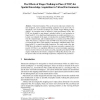Free Online Productivity Tools
i2Speak
i2Symbol
i2OCR
iTex2Img
iWeb2Print
iWeb2Shot
i2Type
iPdf2Split
iPdf2Merge
i2Bopomofo
i2Arabic
i2Style
i2Image
i2PDF
iLatex2Rtf
Sci2ools
108
Voted
SG
2010
Springer
2010
Springer
The Effects of Finger-Walking in Place (FWIP) for Spatial Knowledge Acquisition in Virtual Environments
Abstract. Virtual environments (VEs) can be used to study issues related to human navigation, such as spatial knowledge acquisition. In our prior work, we introduced a new locomotion technique (LT), named "Finger-Walking-in-Place (FWIP)", for navigation tasks in immersive virtual environments (IVEs). The FWIP was designed to map human's embodied ability for real navigation to finger-based LT. A two-hand based implementation on a multi-touch device (i.e., Lemur) was evaluated. In this paper, we introduce the one-handed FWIP refined from the original design, and its implementation on a Lemur and an iPhone/iPod Touch. We present a comparative study of FWIP versus the joystick's flying LT to investigate the effect of the mapping of the human's embodied ability to the finger-based LT on spatial knowledge acquisition. This study results show that FWIP allows the subjects to replicate the route more accurately, compared to the joystick LT. There is no significant diff...
Computer Graphics | Finger-based Lt | Knowledge Acquisition | SG 2010 | Spatial Knowledge Acquisition |
| Added | 15 Feb 2011 |
| Updated | 15 Feb 2011 |
| Type | Journal |
| Year | 2010 |
| Where | SG |
| Authors | Ji-Sun Kim, Denis Gracanin, Kresimir Matkovic, Francis K. H. Quek |
Comments (0)

